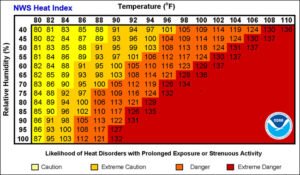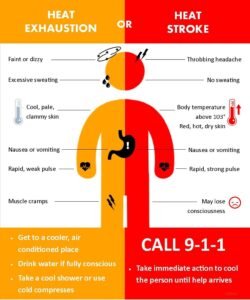
Heat Exhaustion Vs. Heatstroke
By Coach Adolfo Salgueiro
Once again, the usual disclaimer: I am not a doctor, so please do not take medical advice from me. If you have any questions on what you are about to read, please consult a professional, which, yet once again, it is not the author of this blogpost. Now, let’s proceed.

Running in the summer heat requires a certain level of preparation to avoid heat related issues, including death (Jonas Ferlin, pexels.com)
As we enter the Summer months in the Northern Hemisphere and the coolness of the spring weather turns into a combination of heat and humidity that can make even the most motivated runner miserable, the time has come to refresh our knowledge on two important concepts. It is extremely important to understand and differentiate the signs and symptoms of heat related illnesses, such as heat exhaustion and heatstroke. They are both serious conditions, but one can lead to death.
According to the Mayo Clinic’s website, there are three heat-related syndromes that may affect your body depending on your exposure to extreme heat conditions. In order of severity, they are: heat cramps, heat exhaustion and heatstroke.
Heat Exhaustion is caused by exposure to high temperatures, particularly when combined with high humidity and strenuous physical activity. Without prompt treatment, it can turn into a heatstroke, a life-threatening condition that can be prevented by avoiding entering in the heat exhaustion zone in the first place.
Heatstroke is a condition caused by your body overheating, usually as result of prolonged exposure to physical exertion in high temperatures. This most serious form of heat injury, it can occur if your body temperature rises to 104 F (40 C) or higher.
Certain conditions and medicines can enhance your risk of a heat-related illness. Ask your doctor if any of your medical history or current prescriptions can make you more susceptible to these diseases considering your level of physical activity during the warmer months.
I can’t state enough how important to know and understand the symptoms of each one of these syndromes. Not only it could help you prevent them, but it can avert a tragedy.
Heat Exhaustion
The evaporation of your sweat regulates your body temperature. However, when you exercise strenuously or otherwise overexert yourself in hot, humid weather, your core temperature (body\’s heat combined with environmental heat) fails to regulate, preventing your body to cool itself. A normal core temperature is around 98.6 F (37 C).
If you don’t deal with this situation immediately, it may develop into a dreaded heatstroke.
The symptoms of Heat Exhaustion are:
-
Cool, moist skin with goose bumps
-
Heavy sweating
-
Faintness
-
Dizziness
-
Fatigue
-
Weak, rapid pulse
-
Low blood pressure upon standing
-
Muscle cramps
-
Nausea
-
Headache
Should you feel these symptoms, stop your activity immediately, move to a cooler place, drink cool water and/or sports drinks and rest. If these symptoms don’t get better within in an hour, contact your doctor. Remember you are avoiding at all costs to have this escalate into a heatstroke.
Heatstroke
Heatstroke not only requires immediate treatment, but it can quickly injure the brain, heart, kidneys, and muscles. Damage can get worse the longer treatment is delayed and lead to serious complications and, once again, even death.
The symptoms of Heatstroke are:
-
High body temperature (over 104 F or 40 C),
-
Altered mental state or behavior (Confusion, agitation, slurred speech, irritability, delirium, seizures),
-
Alteration in sweating (skin feels hot and dry to the touch),
-
Nausea and vomiting,
-
Flushed skin. (Skin may turn red as the body temperature increases),
-
Rapid breathing (rapid and shallow),
-
Racing heart rate (Pulse may significantly increase),
-
Headache (Throbbing).
Prevention
-
It is imperative to be proactive, both for ourselves and on behalf of our running mates, in the avoidance of situations that may trigger heat exhaustion during the hot summer months. The Mayo Clinic recommends the following:
-
Wear loose-fitting, lightweight clothing,
-
Protect against sunburn,
-
Drink plenty of fluids,
-
Take extra precautions with certain medications (ask your doctor),
-
Take it easy during the hottest parts of the day,
-
Get acclimated to the new weather conditions.
Last year we wrote a blog post on Training Adjustments for the Summer Months, which may be worth revisiting as we prepare for the upcoming weather conditions.
Let’s take a little bit of time and learn about heat exhaustion and heatstroke so we can prevent a tragedy.



